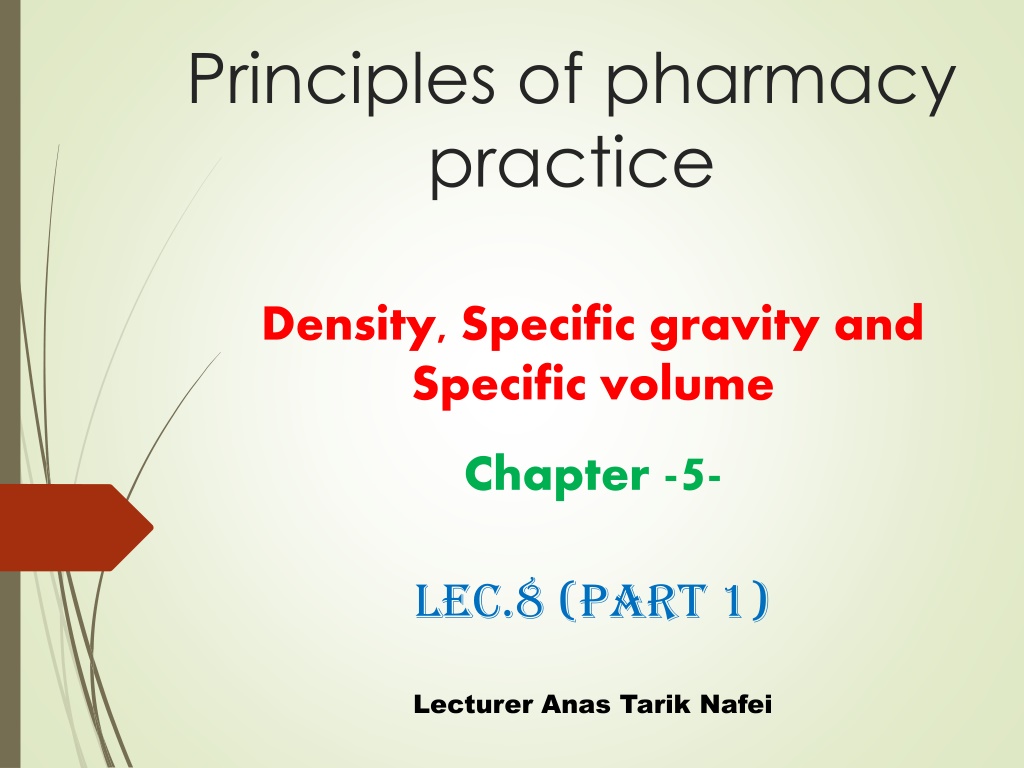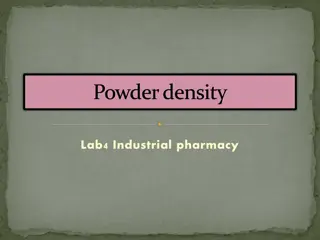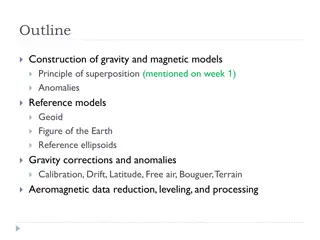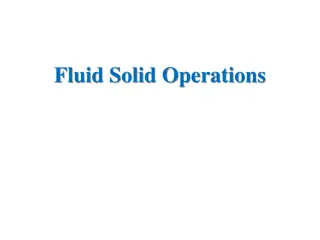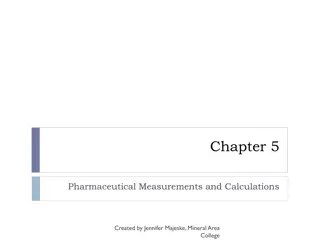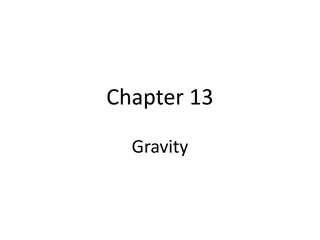Understanding Density and Specific Gravity in Pharmacy Practice
Density and specific gravity are important concepts in pharmacy practice for measuring mass and volume relationships of substances. Density is the mass per unit volume of a substance, usually expressed in grams per cubic centimeter, while specific gravity is the ratio of the weight of a substance to the weight of an equal volume of a standard substance. This article explains how to calculate density, specific gravity, and apply them in converting weight to volume and vice versa, with practical examples for better understanding.
Download Presentation

Please find below an Image/Link to download the presentation.
The content on the website is provided AS IS for your information and personal use only. It may not be sold, licensed, or shared on other websites without obtaining consent from the author. Download presentation by click this link. If you encounter any issues during the download, it is possible that the publisher has removed the file from their server.
E N D
Presentation Transcript
Principles of pharmacy practice Density, Specific gravity and Specific volume Chapter -5- Lec.8 (part 1) Lecturer Anas Tarik Nafei
Objective: Define density, specific gravity, and specific volume and determine each through appropriate calculations. Calculate specific gravity from data derived from the use of a pycnometer. Apply specific gravity correctly in converting weight to volume and volume to weight
Density Density (d) is mass per unit volume of substance. It is usually expressed as grams per cubic centimeter (g/cc). Because the gram is defined as the mass of 1 cc of water at 4 C, the density of water is 1 g/cc. a In United States Pharmacopeial (USP) states that 1 mL may be used as the equivalent of 1 cc, the density of water may be expressed as 1 g/mL Density may be calculated by dividing mass by volume, that is:
???? ?????? Density = Thus, if 10 mL of sulfuric acid weighs 18 g, its density is: Density = ?? (?) ?? (??)= 1.8 grams per milliliter
Specific gravity (sp. gr.) Is a ratio, expressed decimally, of the weight of a substance to the weight of an equal volume of a substance chosen as a standard, both substances at the same temperature or the temperature of each being known. Water is used as the standard for the specific gravities of liquids and solids; the most useful standard for gases is hydrogen. ?????? ?? ????????? ?????? ?? ????? ?????? ?? ????? Specific gravity =
Thus, if 10 mL of sulfuric acid weighs 18 g, and 10 mL of water, under similar conditions, weighs 10 g, the specific gravity of the acid is: Specific gravity = ?? ? ?? ? = 1.8 Substances that have a specific gravity less than 1 are lighter than water. Substances that have a specific gravity greater than 1 are heavier than water
Example 1: If 54.96 mL of oil weighs 52.78 g, what is the specific gravity of the oil? Answer: 54.96 mL of water weighs 54.96 g Specific gravity of oil= 52.78 (g)/ 54.96 (g) = 0.9603 Example 2: If a pint of a certain liquid weighs 601 g, what is the specific gravity of the liquid? Answer: 1 pint =473 mL 473 mL of water weighs 473 g Specific gravity of liquid= 601 (g) /473 (g) = 1.27
Density versus Specific Gravity The density of a substance is a concrete number (1.8 g/mL in the example) whereas specific gravity, being a ratio of like quantities, is an abstract number (1.8 in the example). Whereas density varies with the units of measure used, specific gravity has no dimension and is therefore a constant value for each substance. Thus, whereas the density of water may expressed as 1 g/mL, 1000 g/L, or 62 lb/cu ft, the specific gravity of water is always 1. be variously
Pycnometer or Specific Gravity Bottle A pycnometer is a special glass bottle used specific gravity. Pycnometers are generally laboratory use in volumes ranging from 1 mL to 50 mL. to determine available for Pycnometers have fitted glass stoppers with a capillary opening to allow trapped air and excess fluid to escape. pycnometers have thermometers affixed, because temperature is a factor in specific determinations. Some gravity
Example: A 50 mL pycnometer is found to weigh 120 g when empty, 171 g when filled with water, and 160 g when filled with an unknown liquid. Calculate the specific gravity of the unknown liquid. Answer: Weight of water: 171 g - 120 g = 51 g Weight of unknown liquid: 160 g - 120 g = 40 g Specific gravity= Weight of substance/ Weight of equal volume of water Specific gravity of unknown liquid = 40 (g)/ 51 (g) = 0.78
Use of Specific Gravity in Calculations of Weight and Volume Specific gravity is a factor that expresses how much heavier or lighter a substance is than water, (standard specific gravity -1.0-). Ex: liquid with a specific gravity of 1.25 is 1.25 times as heavy as water, and a liquid with a specific gravity of 0.85 is 0.85 times as heavy as water. Thus, if we had 50 mL of a liquid with a specific gravity of 1.2, it would weigh 1.2 times as much as an equivalent volume of water. An equivalent volume of water, 50 mL, would weigh 50 g, and therefore, the liquid would weigh 1.2 timesthat, or 60 g.
Calculating Weight, Knowing the Volume and Specific Gravity Grams = Milliliters Specific gravity Grams (other liquid)= Grams (of equal volume of water) Specific gravity (other liquid) Example 1: What is the weight, in grams, of 2 fl. oz. of a liquid having a specific gravity of 1.118? 2 29.57 mL =59.14 mL 59.14 mL of water weigh 59.14 g 59.14 g 1.118 =66.12 g, answer. Example 2: What is the cost of 1000 mL of glycerin, specific gravity 1.25, bought at $54.25 per pound? 1000 mL of water weigh 1000 g Weight of 1000 mL of glycerin =1000 g 1.25 =1250 g 1 lb =454 g ??? (?) ???? (?) =??.?? ($) ? ($) x = $149.37, answer
Calculating Specific Volume Specific volume, in pharmaceutical practice, is usually defined as an abstract number representing the ratio, expressed decimally, of the volume of a substance to the volume of an equal weight of another substance taken as a standard, both having the same temperature. Water is the standard. Example: Calculate the specific volume of a syrup, 91.0 mL of which weighs 107.16 g. 107.16 g of water measures= 107.16 mL Specific volume of syrup = 91.0 (mL) /107.16 (mL) = 0.849, answer
Note: 1. Whereas specific gravity is a comparison of weights of equal volumes, specific volume is a comparison of volumes of equal weights. Because of this relationship, specific gravity and specific volume are reciprocals. 2. Specific volume tells us how much greater (or smaller) in volume a mass is than the same weight of water. A. a substance that is heavier than water will have a higher specific gravity and a lower specific volume. B. whereas a substance that is lighter than water will have a lower specific gravity and a higher specific volume.
It follows, therefore, that we may determine the specific volume of a substance by dividing 1 by its specific gravity, and we may determine the specific gravity of a substance by dividing 1 by its specific volume.
